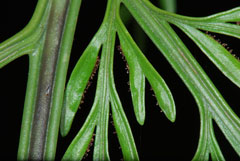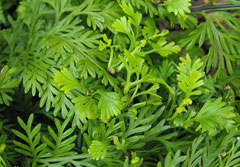 |
|
http://commons.wikimedia.org/wiki/User:Pengo |
 |
| http://commons.wikimedia.org/wiki/User:Stickpen |
Translate this page:
Summary
Form: Rounded, Upright or erect
Physical Characteristics

 Asplenium bulbiferum is an evergreen Fern growing to 0.3 m (1ft) by 0.3 m (1ft in) at a slow rate.
Asplenium bulbiferum is an evergreen Fern growing to 0.3 m (1ft) by 0.3 m (1ft in) at a slow rate.
See above for USDA hardiness. It is hardy to UK zone 10 and is frost tender. It is in leaf all year.
Suitable for: light (sandy), medium (loamy) and heavy (clay) soils and prefers well-drained soil. Suitable pH: mildly acid, neutral and basic (mildly alkaline) soils. It can grow in semi-shade (light woodland) or no shade. It prefers moist soil.
UK Hardiness Map
US Hardiness Map
Synonyms
Plant Habitats
Woodland Garden Dappled Shade; Shady Edge;
Edible Uses
Edible Parts: Leaves Root
Edible Uses:
Root - cooked. Young fronds - cooked. Used before they uncurl[183], they taste somewhat like a slightly bitter asparagus.
References More on Edible Uses
Medicinal Uses
Plants For A Future can not take any responsibility for any adverse effects from the use of plants. Always seek advice from a professional before using a plant medicinally.
None known
References More on Medicinal Uses
The Bookshop: Edible Plant Books
Our Latest books on Perennial Plants For Food Forests and Permaculture Gardens in paperback or digital formats.

Edible Tropical Plants
Food Forest Plants for Hotter Conditions: 250+ Plants For Tropical Food Forests & Permaculture Gardens.
More

Edible Temperate Plants
Plants for Your Food Forest: 500 Plants for Temperate Food Forests & Permaculture Gardens.
More

More Books
PFAF have eight books available in paperback and digital formats. Browse the shop for more information.
Shop Now
Other Uses
References More on Other Uses
Cultivation details
Landscape Uses:Container, Ground cover, Massing, Specimen, Woodland garden. Requires a moist humus-rich soil in semi-shade. Plants are probably not hardy outdoors in Britain but may be worth trying in very sheltered positions. The young growth in spring, even on mature plants, is frost-tender and so it is best to grow the plants in a position sheltered from the early morning sun[K]. Members of this genus are rarely if ever troubled by browsing deer[233]. Special Features:
Attractive foliage, Not North American native, Naturalizing, There are no flowers or blooms.
References Carbon Farming Information and Carbon Sequestration Information
Temperature Converter
Type a value in the Celsius field to convert the value to Fahrenheit:
Fahrenheit:
The PFAF Bookshop
Plants For A Future have a number of books available in paperback and digital form. Book titles include Edible Plants, Edible Perennials, Edible Trees,Edible Shrubs, Woodland Gardening, and Temperate Food Forest Plants. Our new book is Food Forest Plants For Hotter Conditions (Tropical and Sub-Tropical).
Shop Now
Plant Propagation
Spores - best sown as soon as they are ripe on the surface of a humus-rich sterilized soil. Keep the compost moist, preferably by putting a plastic bag over the pot. Germinates in spring[1]. Spring sown spores germinate in 1 - 3 months at 15°c[134]. Pot on small clumps of plantlets as soon as they are large enough to handle and grow them on in light shade in a cold frame or greenhouse. Keep them humid until they are well established. When they are at least 15cm tall, plant them out into their permanent positions in late spring or early summer. This plant can also be propagated by means of small bulblets that form on the sides of leaves in the growing season. Pot these bulblets up when they detach easily from the parent plant and grow on in the greenhouse for at least the first winter.
Other Names
If available other names are mentioned here
Native Range
Coming Soon
Weed Potential
Right plant wrong place. We are currently updating this section.
Please note that a plant may be invasive in one area but may not in your area so it's worth checking.
Conservation Status
IUCN Red List of Threatened Plants Status :

Growth: S = slow M = medium F = fast. Soil: L = light (sandy) M = medium H = heavy (clay). pH: A = acid N = neutral B = basic (alkaline). Shade: F = full shade S = semi-shade N = no shade. Moisture: D = dry M = Moist We = wet Wa = water.
Now available:
Food Forest Plants for Mediterranean Conditions
350+ Perennial Plants For Mediterranean and Drier Food Forests and Permaculture Gardens.
[Paperback and eBook]
This is the third in Plants For A Future's series of plant guides for food forests tailored to
specific climate zones. Following volumes on temperate and tropical ecosystems, this book focuses
on species suited to Mediterranean conditions—regions with hot, dry summers and cool, wet winters,
often facing the added challenge of climate change.
Read More
Expert comment
Author
G.Forst.
Botanical References
Links / References
For a list of references used on this page please go here
Readers comment
© 2010, Plants For A Future. Plants For A Future is a charitable company limited by guarantee, registered in England and Wales. Charity No. 1057719, Company No. 3204567.